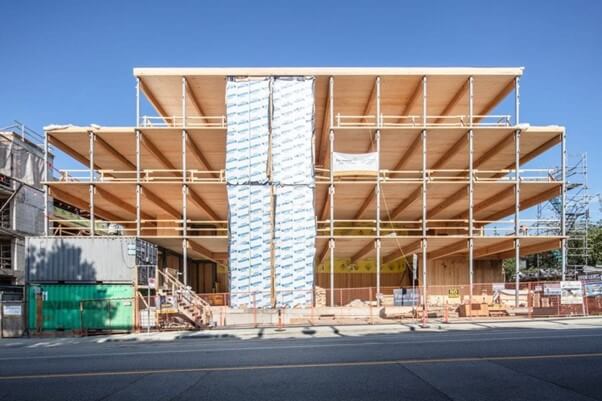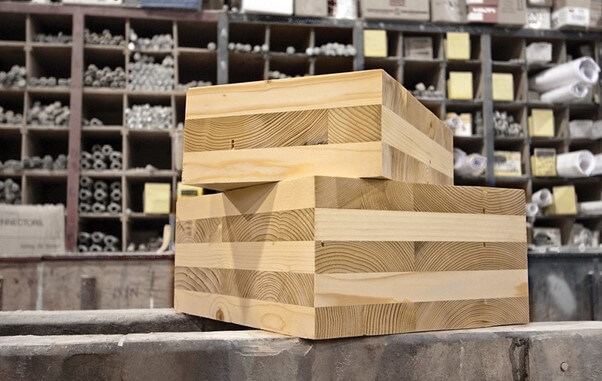Why rocking CLT shear walls are key to seismically resilient mass timber buildings
As mass timber soars in popularity – the number of mass timber buildings in the USA alone is forecast to double every two years – engineers and architects are having to address the challenge of building mass timber structures in high seismic areas such as in Japan, New Zealand, USA, Canada and Italy.

One solution to this challenge is to incorporate rocking CLT shear walls into the mass timber structure. In this article we explain what a rocking CLT shear wall is and why they are used for seismic strengthening.
First, what is a shear wall?
A shear wall is a type of wall intended to resist lateral forces on the building. Lateral forces are typically caused by wind and in some cases earthquakes. Shear walls are commonly used in larger buildings which have sufficient mass to require a lateral force resisting system.
Shear walls are a popular choice in structural design of earthquake resistant buildings for a number of reasons:
- This wall is resistant to structural and non-structural stresses in earthquake-prone zones. As a result, the components of the building are less likely to be destroyed.
- The shear wall design of the structure is efficient in terms of reducing construction costs and minimizing seismic damage.
- This wall can be erected in any shape that is required, and it will offer adequate support for the shape.
- This type of wall might be able to help the building make better use of its available space.
- The shear wall provides seismic strength and stiffness when the building is aligned properly.
- These walls, which are engineered to withstand lateral winds and seismic pressures, are often found in multi-level constructions.
- The building’s construction can be accelerated thanks to the shear wall.
- The structure of the building can be lighter weight, and have less embodied carbon.
OK, and what is CLT?
Cross-laminated timber (CLT) is a type of mass timber that is becoming popular in the construction market as a feasible option for mid- to high-rise timber buildings, particularly those needing seismic protection. Used in Europe for more than 20 years, it is now gaining traction in international markets such as North America.
CLT is made by finger jointing kiln-dried dimensional lumber to the required size and gluing it together in perpendicular layers. The layering is repeated to the desired thickness, typically three, five, or seven layers. These solid panels are then compressed and set to dry. The result is a product that is strong and stable and consistent in a way that unmodified timber isn’t.

As a building material CLT has a number of advantages:
- Lighter so requires a smaller foundation
- Has less mass to be resisted in an earthquake
- Prefabrication speeds up delivery and installation
- A renewable carbon-sequestering resource with low embodied carbon
- Fire resistant
When it comes to shear walls, CLT is great because it can be custom fabricated to any size – which helps with balancing the constraints of structural design, building footprint and aesthetics. In addition, its lightness means that the structure will be subject to lower accelerations in an earthquake. That reduces seismic demands on the mass timber building.
The use of CLT shear walls is becoming more standardized too, speeding adoption. In the US, design and specification is supported by inclusion of seismic design requirements in 2021’s Special Design Provisions for Wind and Seismic (SDPWS) and in ASCE 7-22 Minimum Design Loads and Associated Criteria for Buildings and Other Structures.
When used as a shear wall in a lateral force resisting system CLT panels provide excellent stiffness. However, by themselves, CLT shear walls do not dissipate a lot of energy and have limited ductility. Ductility and energy dissipation must come from the mass timber connection system.
Put them together – what’s a rocking CLT shear wall?
A connection system that allows the CLT shear wall to rock can have major advantages over a fixed shear wall. The idea is that under extreme loads, the shear wall will be allowed to lift up on one side and then ‘rock’ back into place when the load comes off.
Rocking CLT shear walls are a key component of seismic resilient design because they:
- Add stiffness, reducing peak displacements
- Can result in less damage to the structure and building
- May result in less permanent displacement
- Reduce tension demands on the foundation.
For a rocking CLT shear wall to work there needs to be some kind of self-centering mechanism. Several approaches have been tried in relation to shear walls notably post-tensioning cable systems and more recently Tectonus self-centering devices.

Sound useful?
In summary, rocking CLT shear walls, are a great way to address seismic risk and increase earthquake protection because they are lightweight, sustainable, and can result in a low damage design.
If you’re considering using a CLT shear wall and you have a multi-level structure in a high seismic area, get in touch because we might be able to help we can help. Let’s talk.
